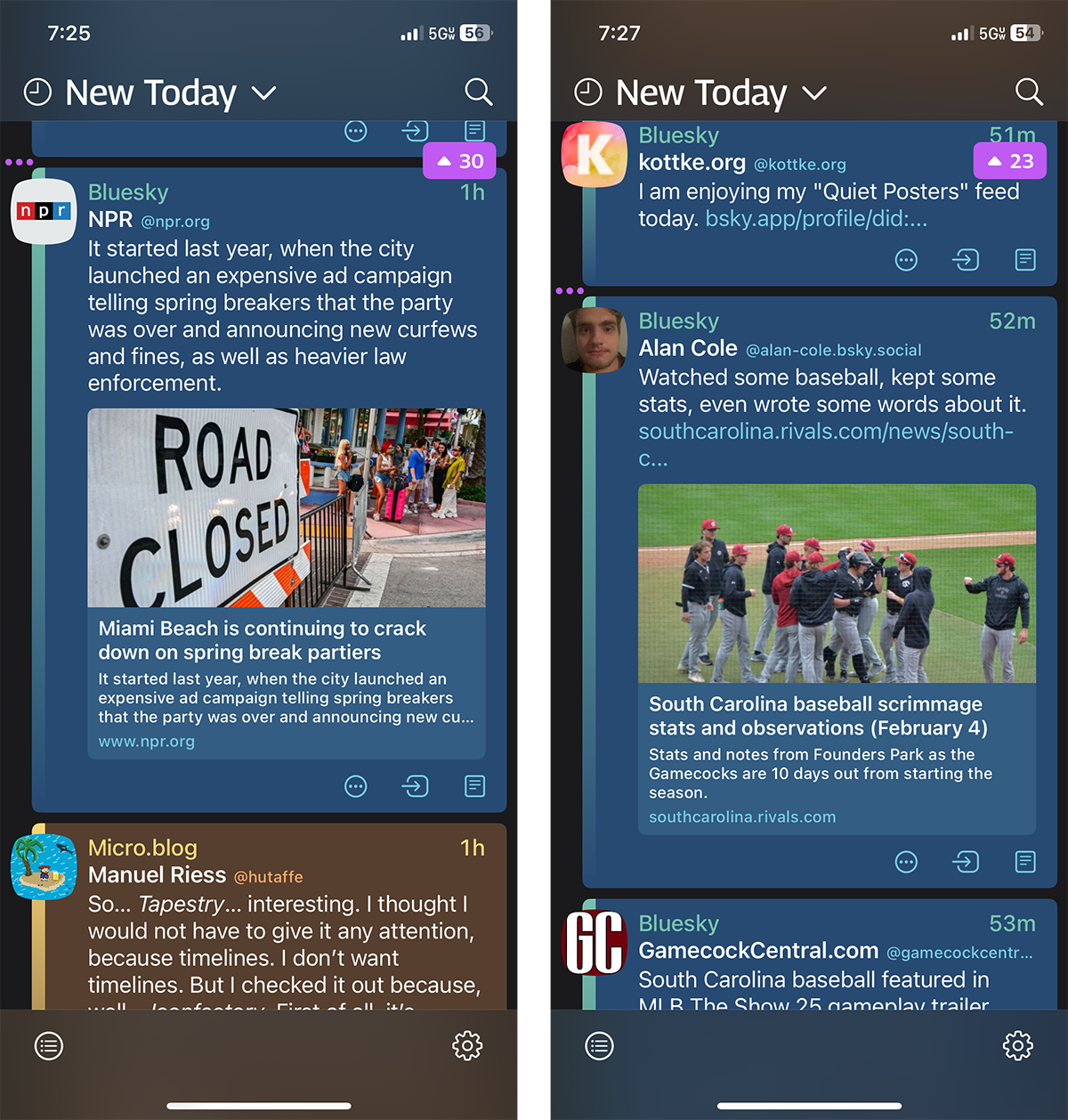Me: I can’t believe no one is talking about Clemson losing to Syracuse.
Also Me: I forgot that I blocked “Clemson” and “Dabo” in my social media apps so I didn’t have to listen to people talk about Clemson.
Thinking about social media… the good and the bad.
Me: I can’t believe no one is talking about Clemson losing to Syracuse.
Also Me: I forgot that I blocked “Clemson” and “Dabo” in my social media apps so I didn’t have to listen to people talk about Clemson.
Dave Winer writing about the “the Writer’s Web”:
The web was initially designed for writers. Styling, links, paragraphs, titles (at all levels). The ability to edit. No character limits. That’s what we had to work with when we started blogging in the mid-late 90s.
What happened to the writer-centric web I loved in the late 1990s? Building a regular readership is challenging. In the earliest days, sites linked to other sites. Bloggers shared work from other bloggers. RSS provided the ability to subscribe to sites, but after Google killed Reader, the focus turned exclusively to search engines and social media. The competition to be at the top of the search results reshaped writing on the web. The ever-changing social media algorithm provided an audience for writers, but maintaining that audience changed the nature of writing on the web.
Blogs became about ad revenue. Search engine traffic and optimization. Building a “side gig.”...
When the Iconfactory announced their Tapestry Kickstarter, I backed it immediately. I’ve been a fan of the Iconfactory’s work for decades, and was a loyal user of Twitteriffic before Musk cut off the API. I’ve had beta access for months as a Kickstarter perk and I’ve been using it daily.1 Now that Tapestry is released to everyone, I wanted to write a little review with some thoughts about how it’s working for me.

One app for pretty much everything. Tapestry is a unified feed reader. You build a feed from a variety of sources and “connectors.” I’ve used connectors to bring in my Micro.Blog, Mastodon and Bluesky social timelines. I still use Feedbin as a traditional feed reader so I’ve also some of my favorite RSS...
In one of my early grad school classes, we had a conversation and some readings on parasocial relationships… mostly one-sided relationships you “build” with people that you watch on tv, listen to on the radio, or subscribe to their podcasts. We think we know these people. Maybe at some point we met them, but our real “relationship” is surface level. We might know their favorite athlete or actor, but have no idea what their spouse’s name is. We may know all about them, but they don’t actually know we exist.
(My grandmother had a very strong parasocial connection to the Augusta, Georgia NBC affiliate morning show hosts. She would tell me all about them when I visited, as though she knew them.)
Social media is a little different than local television celebrities. You can have interchanges and discussions, but the reality is that these are also incomplete. You can’t get to know...
The last two weeks has seen a surge in Bluesky usage. I’ve been on Bluesky a little since the early days. I liked the service, but I didn’t know any one there. That’s changed now and lots of friends are posting. That’s added a touch more complexity, so I figured I’d share how I’m handling my personal social media right now.
A couple of random things I’ve noticed lately:
Pluralistic: You should be using an RSS reader:
RSS basically works like social media should work. Using RSS is a chance to visit a utopian future in which the platforms have no power, and all power is vested in publishers, who get to decide what to publish, and in readers, who have total control over what they read and how, without leaking any personal information through the simple act of reading.
Professionally, I feel like I need to maintain a LinkedIn profile. Also, I have no idea what to do with LinkedIn.
I wrote a blog post in early 2019, trying to make a distinction between “open” social platforms that thrived on interoperability compared to “captive” networks that trap you in their system. As an aside, I also noted the difference between “indie” social and “open” social and added this footnote:
I recognize that the concept of an open social network from a large corporation might seem absurd in today’s environment, but you never know.
Five years later, we have Threads, a somewhat open social network from a large corporation with a track record of building toxic captive networks. The word “open” in this case is distinct from “indie,” since no one can ever claim that Meta is a small independent company. But in the case of Threads, they do seem to be moving toward being more open.1
I think it’s important to make a distinction,...
The Sticker Mule email arrived in my inbox, but I didn’t see it at first. Instead, I saw the backlash on Threads.
Here’s the thing, I knew the owner was conservative, but it didn’t really matter to me. I’d randomly order stickers (or keychains) whenever they had a great special. And they ran specials a lot.
Many companies take stands on issues as a way to signal their values. But most of the time, those topics are carefully chosen to align with their customer beliefs. There is an entire discipline in public relations scholarship called Corporate Social Responsibility that studies this strategy.
But this crosses a line. Blasting your entire business mailing list with a political message — a mailing list that is a massive asset to your sales funnel — is just stupid.
Why? You are choosing to voluntarily spam your mailing list with a political message that half of your list likely...

I wrote a post in 2016 asking how I would deal with the inevitable demise of Twitter. And followed up with posts in 2018, 2022 and 2023.1
In each of the post, one common refrain kept resurfacing. There is no equal for following a live event on Twitter. The last month or so, there have been several events in tech and sports that I would have followed closely on Twitter.
You know what? I didn’t miss Twitter at all.
Instead, I stuck with Micro.Blog and Threads. On Micro.Blog, I follow not only other Micro.Blog users, but I also follow a number of Mastodon users who I previously followed on Twitter. Most of those people are journalists or experts who I do not know personally. On Threads, I follow mostly people that I know personally, many...